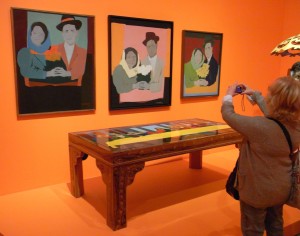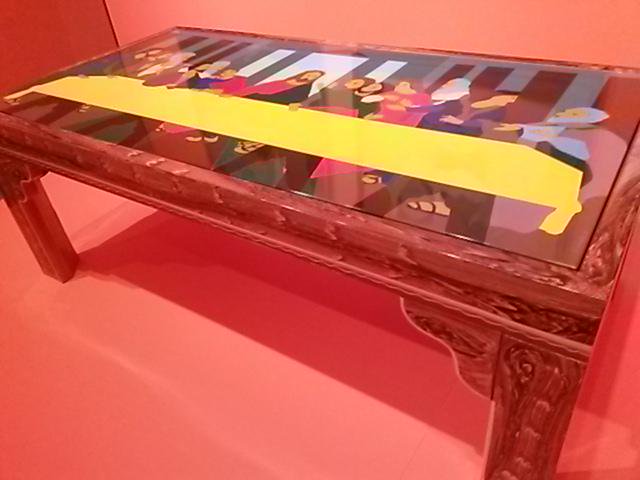While in London visiting the Frieze exhibition I heard that the renowned Colombian artist Beatriz González had work included at “The World Goes Pop” exhibition at the Tate Modern…so I decided to go along.
The Tate Modern is generally free to enter if you want to view its collection but as this was a special show there was a £14.50 (or £16 with a donation) charge for the general public. The museum itself is located quite centrally in Southwark along the South Bank of the river Thames and is reasonably easy to reach.
The exhibition was themed around pop art and it was divided into different sections The collection was curated by Flavia Frigeri and Jessica Morgan and and I think they have done good job after spending several years looking for pop art that was not defined by its commerciality.
“It’s pop art definitely that does have a twist and very often it has a political twist to it which is something you don’t always see with your more traditional pop artists,” commented Flavia Frigeri in relation to the whole show.
Beatriz González’ work was placed into a section called folk art and although to me the works of the other artists present in that section did seem more like folk art it doesn’t seem to me to be the best fit especially given the nature of her work as actually described in the curatorial process as being of a strongly political nature.
Much of Beatriz Gonzalez’ artistic formation was born with the period known as “La Violencia” (“The Violence”) which started in 1948 when she was just 10 – an age when most of us start to become more aware of what goes on around us – and which continued through to around 1958.
What was a surprise to me, though perhaps it shouldn’t have been given the standard of the museum was that the pieces chosen to be shown are arguably her most famous/promoted works which date back to the mid 60s and early 70s and perhaps her most representative of that period….but she has done much more work since then none of which was included perhaps due to the time period over which the curators wanted to consider the creation of “pop art”.
“Los suicidas de Sisga” (1965) – The Sisga Suicides
Los suicidas de Sisga earned Beatriz Gonzalez a prize in the National Art Salon of 1965.
“The Sisga Suicides” painting number 1, 2 and 3 resides in three different collections:
– the first is from the Diana and Bruce Halle private art collection
– the second from the “La Tertulia” museum
– the third from the Colombian National Museum in Bogota
The Sisga bridge crosses a gorge and is located about an hour and a half north east of Bogota. It is situated beside a reservoir that provides Bogota with part of its water needs. It was there that the desperate couple decided to end their lives.
Beatriz Gonzalez and others were of course highly impacted by this desperate event and as such she chronicled it through her art using the pictures of the lovers that appeared in the local press at the time. Her criticism was of the presses macabre interest in the event, often called “amarillismo” or “yellow journalism” which basically refers to its crude and striking nature that many sensationalist “newspapers” used as their angle, befitting to the gutter press rather than serious news establishments. It was also perhaps made as a commentary on the continued interest in violent events at a time when the first guerrilla were starting to form looking to combat the wealthy “owners” of the political establishment.
To the art critic Eduardo Serrano, the “Sisga Suicides” is a work “that marks a interest in social problems which focuses the problems of people of few resources, and which until that moment was not a theme of priority in Colombian art.”*
It is the style of the work in itself that lends to its classification as pop art:
simple line definitions and simple colours reminiscent of Warhols work. Were it not so, this style would perhaps be simply classed as naif, despite the fact that Gonzalez studied fine arts and art history at the University of the Andes and in 1966 studied graphics in Rotterdam.
“La Última Mesa” (1970) – “The Last Table”
“The Last Table” depicts her rendition of da Vinci’s “The Last Supper” by imposing it upon the actual table surface. The object measures 760 x 2053 x 1052 mm and is dinner table size. Whether it was her intention or not, it was still not unusual for dead bodies to be laid out on the dinner table. An unconscious reflection of the society, its violence, its’s religion and culture?
As an artist instead of using traditional and fine linen, Beatriz González decided to use metal, furniture, tires, shower curtains, pots. Her characters have been the political, social and religious aspects of life in Colombia and “La Última Mesa” is a prime example of that.
“Looking at others through the eyes of others” is how Beatriz González describes her art and the complete works of Beatriz Gonzalez is a critical and acute journey through the history of Colombia.
Exhibition Dates & Details
The exhibition continues through to 24th January 2016 and I think it a very enjoyable couple of hours could be had here that would allow you to get to see pop art presented in a different way and see some new artists that are perhaps eclipsed by the ever-present giants such as Warhol, Lichtenstein and Indiana.
An audio guide is available for £4 and a softcover book for £25. I think they would get more book sales if they gave a £4 discount on its purchase to those who bought the audio guide….but I´ll leave the marketing up to the Tate 😉
Beatriz González: The World Goes Pop
The EY Exhibition: Eyal Ofer Galleries, Tate Modern, London
15 Sept – 24 January 2016
* Sourced and translated from Semana
** If you would like to know more about Beatriz Gonzalez’ work I highly recommend this interesting blog by Alex Kittle and this excellent interview published in Spanish with Beatriz González reviewing her life and art in Colombia by María Paulina Ortíz.


Leave a Reply